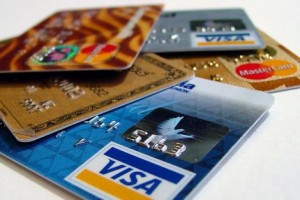(ThyBlackMan.com) In a new round of pitches in the mail, online and the phone, lenders are offering to help consumers manage their money – that is, if they’ll just sign up for a credit card.
Coming from companies that make much of their money when customers spend with abandon, it’s an incongruous pitch. And yet, a card launched this week by TD Bank is just one of three new offerings that promise to help users pay down debt; Chase’s Blueprint promises to help cardholders manage their daily spending and budget for big purchases. Another pair of cards says it will help parents teach teens to use plastic responsibly. “Their new marketing tactic is that they’re your ally,” says Bill Hardekopf, chief executive at http://www.LowCards.com, which tracks credit card offers.
Some are aggressively pushing these products, too: Chase’s Slate card with Blueprint counts for 7% of all credit-card mail offers during the fourth quarter of 2010, up from less than 0.5% during the third quarter 2009 when  it first launched, according to Synovate Mail Monitor, which tracks credit card mail. And American Express says it’s inserting pitches for its teen prepaid card in monthly billing statements received by parents who are existing card members.
it first launched, according to Synovate Mail Monitor, which tracks credit card mail. And American Express says it’s inserting pitches for its teen prepaid card in monthly billing statements received by parents who are existing card members.
The offers are clearly aimed at soothing consumers’ lingering anxieties about using their credit cards. Because while customers are starting to charge again, they’re not back to pre-recession levels – for example, purchase volume at Visa, the largest credit card network, totaled $599 billion for the 12 months ending June 30, still down 4% compared to the same period in 2007. As they slowly return to buying on credit, these card offers are banks’ efforts to increase consumers’ trust so that they keep using their cards, says Hardekopf.
But the companies’ definition of what’s good for consumers may not match cardholders’. For one thing, the cards don’t always have the lowest rates or fees, says Odysseas Papadimitriou, CEO of CardHub.com, a credit card comparison web site. Following 0% APR promotional periods (when offered) rates of some of these credit cards spike up to 22%, while the average credit card interest rate is around 14%. And prepaid cards geared toward teenagers, but mostly marketed to their parents, are accompanied by fees of around $5 a month and ATM withdrawal fees of around $1.50.
For their part, lenders say their new cards can help consumers manage their expenses and pay down debt faster. “This card is designed to help students build their credit confidently and reward them for responsible credit use,” says a Capital One spokeswoman about the bank’s new Journey card for college students; launched last month, the card gives cash rewards to cardholders who pay their bill on time. But banks say high interest rates remain unavoidable in part because of tight lending standards. “We constantly evaluate the risks and cost of funding credit card loans,” says a Chase spokeswoman.
Here’s a look at the pros and cons of these services and their bottom line for cardholders.
Be a better budgeter
The card : Chase credit cards with Blueprint
The pitch : Make expenses more manageable
How it works : Cardholders can choose what they’d like to pay off, and when — like singling out everyday items (e.g. groceries, gas) to pay in full each month, then dividing payoff of big-ticket purchases over time. On the purchases they choose to pay in full, cardholders don’t pay interest, and they see their progress on bigger balances on each statement.
Bottom line : Consumers can take each of these steps on their own with a credit card, and in some cases, the savings are an illusion. Paying off $150 of regular monthly expenses plus $100 toward that couch is the same as paying $250 in one shot on a regular credit card. The only difference is that with Blueprint, cardholders won’t pay interest on the everyday purchases they pay off in full each month. “When we talked to our customers, they said it was important to see their progress and to feel in control with a visual aid,” says a Chase spokeswoman as the reason for launching the Blueprint service. Cardholders can qualify for 0% APR for 12 months followed by interest of as low as 11.99% — among the lowest available now. However, rates can run up to 21.99%.
Pay down debt faster
The cards : TD Bank’s Payment Plus; Capital One’s Journey card; Citi’s Forward card
The pitch : Better credit card terms for paying on time
How it works : Each of the three cards give customers a break if they pay their bills on time. The Payment Plus card, introduced this week, cuts interest charges by 50% (with a statement credit) each time cardholders pay at least 10% of their balance on time. For cardholders who pay 5% to 9.99% of their balance, it cuts interest charges by 25%. (Ideally, consumers should pay down their entire balance each month.) The Journey card, which is marketed to college students, gives 1% cash back on all purchases plus a 25% bonus on the cash back earned when a cardholder pays on time. For example, someone who charges $3,000 on their card in a year gets $30 cash back at 1%, plus $7.50 for paying on time. And, with Citi’s Forward card, cardholders who stay under their credit limit and pay on time for three consecutive months see their interest rate drop by 0.25%, which could add up to 2% off the original rate.
Bottom line : The companies say their goal is to reward responsible borrower behavior, but these cards’ interest rates could eat up the pay-down incentives. The average credit card rate is about 14%. TD Bank’s card, for example, charges up to 21.24%. “Given the value and benefits of this card we believe the rate is competitive in the current market place,” says Michael Copley, executive vice president at TD Bank. Capital One’s card comes with a 19.8% APR. The card “is designed for students with average or no credit history, and the APR reflects that level of risk,” says a Capital One spokeswoman. Citi Forward is a slightly better deal with a 0% APR for the first seven months on purchases and for the first year on balance transfers. Then, it switches to 12.99% to 19.99%. Consumers at the high end of this range could find a better deal elsewhere.
Teach teens to be smarter about money
The cards : American Express’ Pass card; the Myplash Prepaid MasterCard
The pitch : Teach teens how to buy only what they can afford
How they work : Both cards are just prepaid cards, souped up and marketed as training wheels before credit cards. To reach teens, American Express is mailing pitches to parents and posting online ads; Myplash offers cards decorated with characters from the latest Twilight movie and popular teen video games. Both companies say the cards can help teach teens financial responsibility, because cardholders can only spend the amount that’s on the card – eliminating the risk of incurring overdraft fees.
Bottom line : It’s true, a teen can do a lot less damage with one of these cards than with a credit card. But the fees are steep, says Hardekopf. Both cards charge a monthly fee of around $4 to $5, plus additional charges to withdraw money from an ATM. (American Express waives that fee through October.) At Myplash there’s also a $4.95 fee when the card is loaded from a credit or debit card, and $1.95 to speak with a live customer service agent in some cases. All that money, and your kid doesn’t even get the benefit of building a credit history – for good or for ill. An American Express spokeswoman says the card has several purposes: “Parents told us they were looking for a safer way to give money to their teens, to use tools to manage and track spending, and to educate teens to better understand money,” she says. Myplash reps also said the card is mostly for learning purposes. “This is a learning tool for teens to see how they spend their money and to learn how to avoid fees,” says Kelly Moore, client relations manager at MetaBank, which issues the Myplash card and has branch locations in Iowa and South Dakota.
Written by AnnaMaria Andriotis
Official website; http://www.smartmoney.com

















The penfed promise card is great for low interest, its important to try to avoid interest charges as you can, if you are paying interest try to reduce your expense level as it is costing you money. Prepaid does NOT help credit.